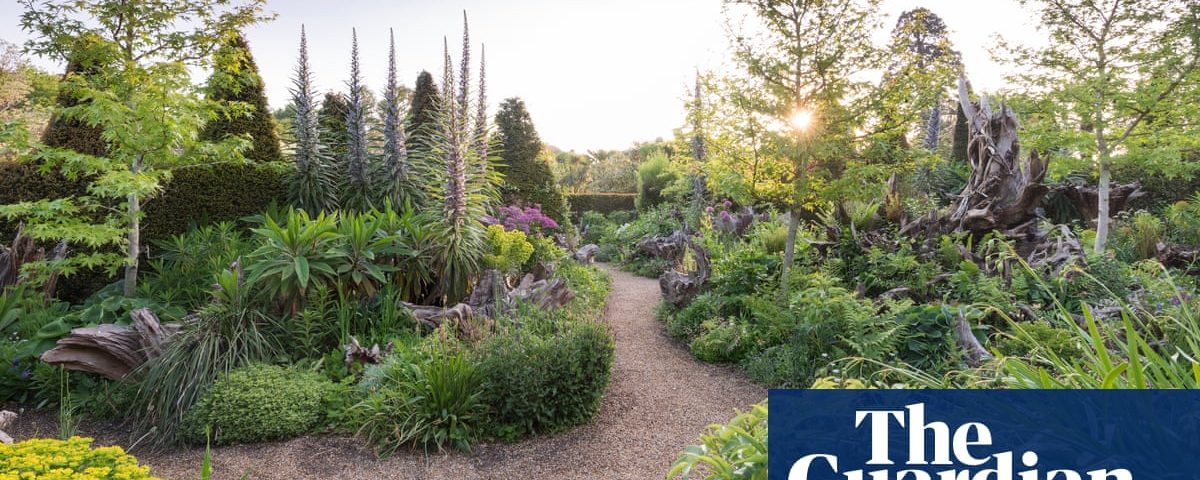G narled, ancient tree stumps squat among the lush lime greens of euphorbias and steel blue hostas. Masses of white and pink Mexican fleabane ( Erigeron karvinskianus ) cascade down them and froth over the edges of the gravel paths. And huge purple lollipops of allium flowers emerge from a mass of greenery below.
This garden may look as if it has been here for ever, yet just seven years ago, it was a plain patch of grass within the walled garden of Arundel Castle , a 40-acre West Sussex estate. That’s when Arundel’s head gardener, Martin Duncan , dreamed up the idea for what he calls a “plantsman’s stumpery”: a garden packed with choice plants, growing in and among a display of upended tree stumps, their roots pointing to the sky.
Erigeron karvinskianus , allium ‘Globe Master’, ferns and bracken. Photograph: Mimi Connolly The stumps themselves are old: the last vestiges of oak, yew and sweet chestnut trees felled by the Great Storm of 1987 around the stately home’s woodland on the South Downs. “Some of the yew trees were at least 400 years old when they fell,” Duncan says. “The foresters sourced the best from the estate woods, high on the South Down hills, and with their help they were brought into the gardens.”
Stumperies – beloved of Victorian gardeners – are traditionally heavily shaded and overwhelmingly green, full of ferns and pulmonarias. Lovely, but not what Duncan had in mind. Arundel’s stumpery is different; only one corner is overlooked by the nearby cathedral, with the rest bathed in sun. That extra light makes it possible to grow a far wider and more colourful plant palette.
With the help of a mini digger, Duncan spent time placing the stumps into the most pleasing pattern, with meandering gravel paths that allow them to be viewed from different angles. They are buried 50cm or more into the ground, trunk-down, roots splayed to the sky. This ensures stability, but also assists with the illusion that these are as permanent a feature as the castle itself. The centrepiece is a mound of earth crowned with two large stumps.
Aquilegia vulgaris var. stellata ‘Ruby Port’. Photograph: Mimi Connolly Each stump is a unique sculptural form, and home to a micro-environment: plants are nestled into the tops, grow around the base and in every conceivable nook and cranny. Spots around the base that fall in shadow are ideal for woodland plants, such as the painted lady fern ( Athyrium niponicum var. pictum ‘Metallicum’), pulmonarias, hostas and toad lilies ( Tricyrtis formosana ); but out in the sunshine, peonies, delphiniums, lupins and angel’s fishing rod ( Dierama pulcherrimum ) thrive. In autumn, six liquidambar trees provide fiery shades.
Flowering bulbs offer up colour, too. The show starts in late winter with clumps of snowdrops, followed by snake’s head fritillaries, scillas and wild tulips, including the flax-leaved tulip ( Tulipa linifolia ) , the Turkestan tulip ( T . turkestanica ) and tulip ‘Lilac Wonder’ ( T . saxatilis (Bakeri Group) ‘Lilac Wonder’). As spring turns to summer, purple alliums pop up: both traditional (‘Purple Sensation’), and quirky A . vineale ‘Hair’ with straggly green blooms, and A. ‘ Spider’, with its firework flowers.
By mid-May, some of the stumps are draped in clambering clematis or passion flower vines. The acid green of Mediterranean spurge ( Euphorbia wulfenii ) provides a foil for the rising spires of giant viper’s bugloss ( Echium pininana ) covered in masses of tiny blue flowers, beloved of bees. This isn’t the only wildlife to be found here. “There’s birdsong, stag beetles, voles running across the paths, and hedgehogs overwintering under leaves,” Duncan says.
Fern Matteuccia struthiopteris ‘The King’, hosta Sieboldiana elegans . Photograph: Mimi Connolly The overall effect is both unorthodox and magical: a place for the imagination to run wild and, indeed, children visiting often assume the garden has a Harry Potter or Hobbit theme. “You can look at the stumps and pick out shapes: sometimes you’ll see an aardvark or a ram’s head,” says Duncan.
Exotic greenery, moss and orchids: an indoor garden full of houseplant ideas Read more The Stumpery at Arundel is 17x22m, but Duncan believes it is possible to downsize the core idea to a smaller, domestic garden, swapping a plain lawn for a densely planted bed centred around one or more stumps. Check local sales sites, eBay and tree surgeons for stumps; opt for hardwoods, such as oak, if you can. Taking the time to position them in the most pleasing formation is vital before digging them into the ground. Soil enhanced with lashings of leaf mould will help woodland plants to thrive. Duncan scatters mixed annual wildflower seed (he uses Pictorial Meadows’ classic mix ) between the stumps to add a natural-looking wash of summer colour from phacelia, poppies, cornflowers and other annuals.
Few have had the chance to experience the Stumpery’s glories in the past year, as the garden closed during lockdown. Duncan and his team have continued to work (social distancing isn’t difficult in such a big space), and a series of videos has allowed the public to watch progress online. But now Arundel Castle garden is open, a site full of upended tree stumps and choice plants sounds like the perfect form of escapism.
All tickets to Arundel Castle ’s gardens must be booked in advance.

